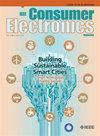隐式多尺度Swin变压器网络图像去噪
IF 10.9
2区 计算机科学
Q1 ENGINEERING, ELECTRICAL & ELECTRONIC
引用次数: 0
摘要
图像去噪已用于各种边缘计算场景,如消费电子产品,以提高图像质量和用户体验。现有的基于卷积神经网络(cnn)和视觉变换的图像去噪方法,都是经验地利用残差神经网络(ResNet)作为基本成分,达到了较好的降噪效果。然而,ResNet在网络设计上缺乏可解释性,也缺乏特征的长期记忆,这可能会限制去噪网络的性能。本文提出了一种用于图像去噪的隐式多尺度Swin变压器网络(IMSNet),该网络从特征记忆的角度引入了隐式欧拉格式。具体来说,设计密集连接的隐式特征提取块(ifeb)来学习噪声图像和干净图像之间的残差映射。IFEB基于隐式欧拉离散化(implicit Euler discreization)重新定义了ResNet的初始跳过连接,提供了网络可解释性和长期记忆。在IFEB中,将多尺度旋转变压器块(MSB)设计为隐式层,用于捕获不同尺度的空间细节和非局部上下文信息。此外,提出了一种跨层特征融合块(CLFF),进一步提高了特征重用能力。与现有的去噪网络相比,大量的实验证明了我们的IMSNet在各种图像去噪任务中的优越性能,以及在资源受限平台(如消费电子设备)上的实际应用中所提出的轻型模型的灵活性。本文章由计算机程序翻译,如有差异,请以英文原文为准。
Implicit Multi-Scale Swin Transformer Network for Image Denoising
Image denoising has been used in various edge computing scenarios such as consumer electronics to improve the image quality and user experience. Existing image denoising methods based on Convolutional Neural Networks (CNNs) and vision Transformers achieve good performance by empirically utilizing residual neural network (ResNet) as basic component. However, ResNet lacks interpretability in network design and also long-term memory of features, potentially restricting the performance of denoising networks. In this paper, we propose an Implicit Multi-scale Swin Transformer Network (IMSNet) for image denoising, which introduces the implicit Euler scheme from the feature memory perspective. Specifically, densely connected implicit feature extraction blocks (IFEBs) are designed to learn the residual mapping between noisy and clean images. The IFEB reformulates the initial skip connection of ResNet based on the implicit Euler discretization, providing both network interpretability and long-term memory. In IFEB, the multi-scale swin Transformer block (MSB) is designed as the implicit layer to capture spatial details and non-local contextual information at different scales. Additionally, a cross-layer feature fusion block (CLFF) is proposed to further improve feature reuse capabilities. Compared to existing denoising networks, the extensive experiments demonstrate the superior performance of our IMSNet in various image denoising tasks, and the flexibility in the practical applications with proposed light model on resource-restricted platforms such as consumer electronic devices.
求助全文
通过发布文献求助,成功后即可免费获取论文全文。
去求助
来源期刊
CiteScore
7.70
自引率
9.30%
发文量
59
审稿时长
3.3 months
期刊介绍:
The main focus for the IEEE Transactions on Consumer Electronics is the engineering and research aspects of the theory, design, construction, manufacture or end use of mass market electronics, systems, software and services for consumers.

 求助内容:
求助内容: 应助结果提醒方式:
应助结果提醒方式:


